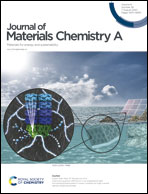A hybrid of MIL-53(Fe) and conductive sulfide as a synergistic electrocatalyst for the oxygen evolution reaction†
Abstract
The development of effective electrocatalysts for sustainable energy conversion and storage is highly desired, but still a considerable challenge due to the sluggish oxygen evolution reaction (OER). Herein, we report a novel composite of MIL-53(Fe) with Ni3S2 nanosheet arrays supported on Ni foam that ingeniously combines the chemical and structural advantages of the MOFs and metal sulfides to perform as a high-performance synergistic OER electrocatalyst in alkaline solution. The hybrid Ni3S2/MIL-53(Fe) simultaneously realizes high electrical conductivity to facilitate charge transfer and abundant coordinatively unsaturated centres, porosity and high surface area to provide a great number of active sites. Strikingly, synergistic electronic interaction between Ni3S2 and MIL-53(Fe) is generated in the hybrid composite. Collectively, the coupled Ni3S2/MIL-53(Fe) exhibits excellent OER performance in comparison to bare Ni3S2 and MIL-53(Fe), with low potentials of 214 and 251 mV to reach current densities of 10 and 100 mA cm−2, respectively. The Tafel slope is 33.8 mV dec−1, which is also markedly lower than those of Ni3S2, MIL-53(Fe) and most reported Ni-based electrocatalysts. The present work paves a promising avenue to design and fabricate highly active and earth-abundant electrocatalysts toward the OER.



 Please wait while we load your content...
Please wait while we load your content...